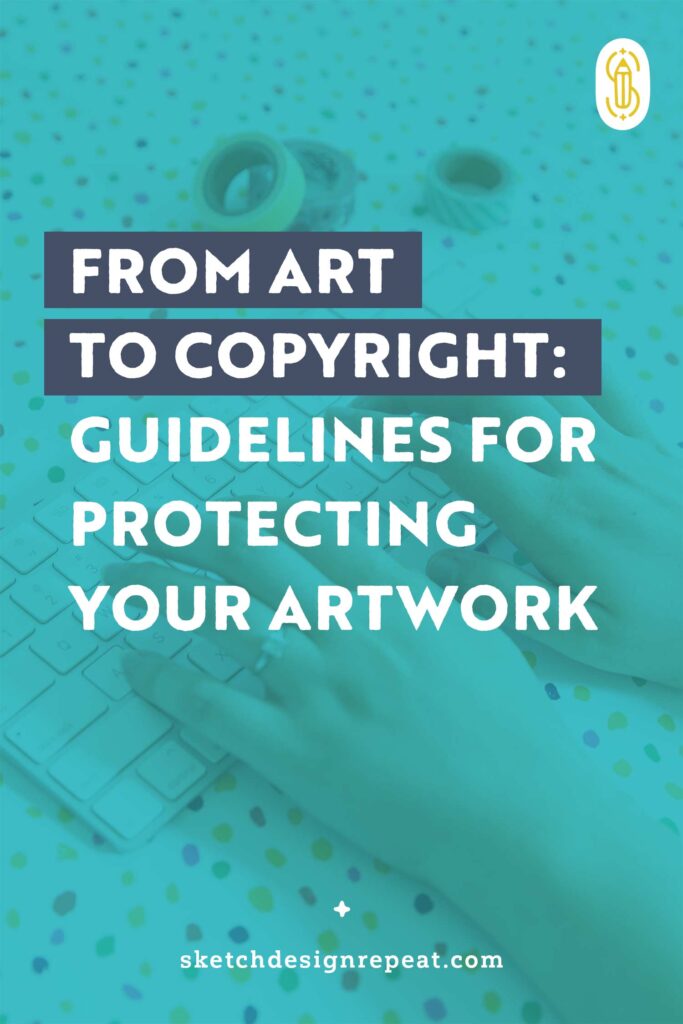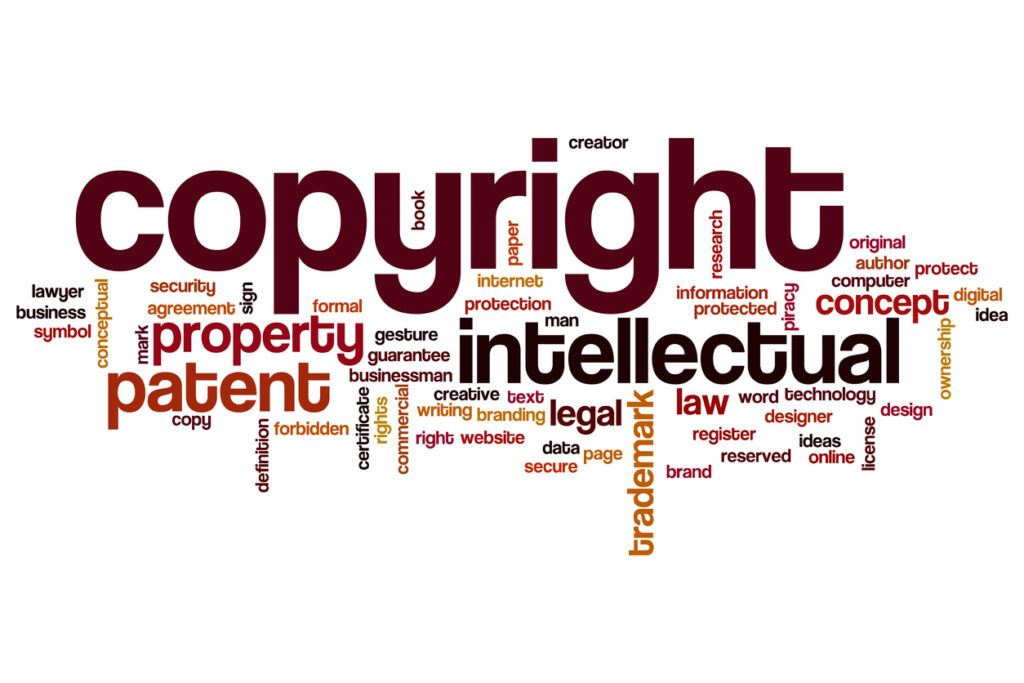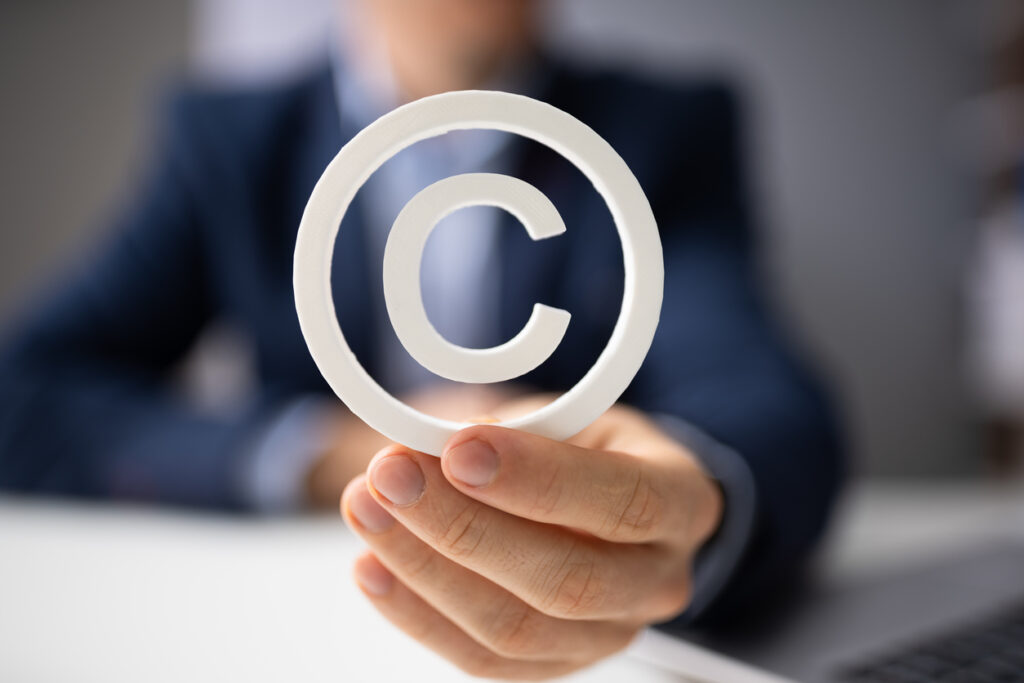The most frequent questions I receive regarding legal issues affecting artists and designers are about copyrights. Because copyrights are so critical to artists and designers, it is important to have a working knowledge of copyright law to protect your artwork and avoid common pitfalls and misconceptions. In question-and-answer format, this article takes a basic look at copyright law to help artists and designers stay on the good side of copyright law.

DISCLAIMER: The information contained in this blog post is intended for informational and educational purposes only and should not be construed to constitute legal advice. Before taking any action, or before refraining from taking any action, based on the information contained in this post, please consult an attorney.
What is copyright law?
Copyright law protects original, tangible works of authorship, including artistic, literary, musical, and dramatic works including photographs, graphics, paintings, designs, sketches, and sculptural works. Essentially, all original works can be copyrighted. Copyright law covers both published and unpublished works, regardless of the nationality or location of the author. Virtually all works created after January 1, 1978, are protected by copyright law. Finally, copyright is not a single right, as the word may suggest, but is a bundle of rights. Any part of the bundle can be retained or sold, leased, licensed, or given away.
What does copyright law do for artists and designers?
Copyright law gives an author or owner of the work the exclusive rights to:
- Reproduce (copy) or distribute the original work to the public;
- Create new works of art based on the original work; and
- Perform or display the work publicly.
In other words, copyright gives the author the power to control the work and to exclude others from doing so. Copyright owners can also authorize others to use their works. The use or copying of any work without permission from the copyright holder is a violation of the Copyright Act.
How is a copyright different from a trademark or patent?
Copyright protects original works of authorship. A patent protects inventions or discoveries. Ideas and discoveries are not protected by copyright law, although the way in which they are expressed may be. A trademark protects works, phrases, symbols, or designs identifying the source of the goods or services of one party and distinguishing them from those of others.
What is not protected by copyright?
Several types of works are generally not protected under copyright law. These include:
- Works that have not been fixed in a tangible form of expression, such as improvisational works or speeches that have not been written down or notated;
- Titles, names, short phrases, slogans, familiar symbols or designs, simple variations of typographic ornamentation, lettering or coloring, simple listings of ingredients or contents;
- Ideas, procedures, methods, systems, processes, concepts, principles, discoveries, or devised; however, a description, explanation, or illustration may be protected; and
- Works consisting entirely of information that is common property and containing no original authorship, such as calendars, height and weight charts, tape measures and rulers, and lists or tables taken from public documents or other common sources. These works are not considered either original or creative.
Do I have to file anything to get a copyright?
No. Copyright springs into existence at the moment the work is created in a fixed and tangible medium. For example, when you save a design file in Adobe Illustrator, your copyright to that design begins when the file is saved to your computer’s hard drive or a computer disc. As long as the work exists in tangible form or can be understood or reproduced with the aid of a machine, it is copyrighted.

How long does a copyright last?
For works published after January 1, 1978, the copyright lasts for the life of the author plus 70 years. However, if the work is made for hire (meaning that the work is done in the course of employment or has been specifically commissioned) or is published anonymously or under a pseudonym, the copyright lasts between 95 and 120 years, depending on when the work was published.
What is the public domain?
All works published before 1924 are in the public domain, meaning that they have no copyright protection and cannot be copyrighted. Such works are freely available for anyone to use. In addition, works published between 1923 and 1963 on which the copyright registration was not renewed are also in the public domain. Works produced by the U.S. government and its employees as a part of their job are in the public domain. State and local government publications are generally not public domain works.
What is publication?
A work is considered “published” when the author makes the work available (for viewing, sale, or licensing) to the public on an unrestricted basis. For example, an original surface pattern design posted on social media would be considered published at the time of posting.
When does copyright protection begin?
Copyright protection exists from the moment the work is created in a fixed and tangible medium of expression. Fixed and tangible mediums include digital and electronic files, as well as traditional methods of artistic expression.
How do I use a copyright notice?
Since March 1, 1989, a copyright notice is no longer required for the work to be protected by copyright law. However, for legal and practical reasons, it is prudent to include the notice on all copyrighted material because it prevents others from claiming “innocent infringement” when unlawfully copying your work. Using the notice also makes it easier to win a copyright infringement case and perhaps collect enough damages to make the cost of the case worthwhile. The very existence of a copyright notice on an original work may also discourage infringement. Finally, including a copyright notice may make it easier for someone to track down the owner and legitimately obtain permission to use all or a part of the copyrighted work.
A proper copyright notice is stated as follows:
©[OR THE WORD “COPYRIGHT”] [YEAR OF FIRST PUBLICATION] by [NAME OF COPYRIGHT HOLDER].
Placing a copyright notice on a work is not a substitute for copyright registration.
Related Article: How To Protect Your Art on Instagram & Online
Is my copyright valid worldwide?
Copyright protection laws are fairly similar worldwide, due to several international copyright treaties, the most important of which is the Berne Convention. Under this treaty, all member countries (there are more than 100 of them) must afford copyright protection to authors who are nationals of any member country. This protection must last for at least the life of the author plus 50 years and must be automatic without the need for the author to take any legal steps to preserve the copyright. Generally, these copyright treaties allow U.S. authors to enforce their copyrights in most industrialized nations and allows the nationals of those nations to enforce their copyrights in the U.S.
Do I need permission to use any part of a copyrighted work, no matter how small?
Yes. It is safe to assume that all work expressed in a fixed and tangible medium is copyrighted, including all material on the internet, unless you can definitively establish that the work is not copyrighted or is in the public domain. To use any part of a copyrighted work, you must obtain permission from the author. Permission to use a copyrighted work is called a “license.” A license must be obtained from the copyright owner before using the copyrighted material. The general rule of thumb is if you do not have express, written permission from the author to use any material, then don’t use it.

Can I use part of someone else’s work if I change the work?
You may not use someone else’s work without their consent no matter how much you change it.
What is copyright registration?
Although a copyright is created automatically when a work is created, there is a procedure for registering a copyright with the Library of Congress. Registration is not required for copyright protection.
There are benefits to registering a copyright. First, registration creates a public record of the copyright. Second, registration of a copyright is required to file a lawsuit for copyright infringement. Third, if a copyright is registered before there is an infringement or within three months after the date of the first publication of a work, the owner of the copyright can claim statutory damages plus attorney’s fees. Statutory damages of up to $100,000 can be awarded for intentional infringement.
Registration is accomplished by filling out a simple form, paying a small fee, and sending a copy of the work to the Copyright Office. The fee for electronic filing for a single author, same claimant, one work, not for hire is $45. A standard application is $65. Registration of a claim in a group of unpublished works (a collection of up to 10 designs) is $85. Collections may only be protected through a single copyright application if every work in the collection is in the same type of medium, all of the works have the same owner, and at least one of the authors has contributed to every one of the works. The collection must also contain works that have all been published, or the entire collection remains unpublished.
Forms can be obtained online from copyright.gov. Use Form VA for works of visual art. It generally takes between three and nine months to receive a certificate of copyright registration. Formal registration of a copyright occurs when the Copyright Office registers the copyright in the work, not when the applicant applies.
What about a collage?
If an artist incorporates any copyrighted material into the collage, there is a risk of infringement. In making a collage, it’s fine to use your work or work that’s in the public domain. However, when collage artists take work from other artists, there is a risk of copyright infringement. One must inquire as to how much of the copyrighted work is used and the impact this use will have on the potential market for the copyrighted work. This is an instance where common sense and good judgment should rule. When in doubt, leave it out.
What is “fair use”?
The fair use doctrine is an affirmative defense to a charge of copyright infringement. It provides a conditional exception to copyright infringement for purposes like education, commentary, parody, news reporting, or certain transformative uses.
There are no bright lines defining when a particular use of a copyrighted work would be judged “fair.” When confronted with the question, courts weigh four interrelated, fact-intensive factors:
- The purpose and character of the use, including whether such use is commercial or is for nonprofit purposes;
- The nature of the copyrighted work;
- The amount and substantiality of the portion used in relation to the copyrighted work as a whole and relative to the purpose of the new work or use, and;
- The effect of the use upon the potential market for the value of the copyrighted work.
As part of the first factor (purpose and character of the use), courts weigh the extent to which the use is transformative, meaning the extent to which the new use alters the original. The more transformative the work, the less significance a court will attach to the other factors that may otherwise weigh against fair use, such as commercialism and copying of significant portions of the work.
Courts have been clear that there is no formula to fair use decisions, and the fact that a work is transformative does not decide the question just as the fact that a use is commercial or that an entire work is copied does not always mean a use is not fair. In the end, fair use decisions are difficult to predict and should be avoided, if at all possible.
What do I do if someone steals my artwork?
For a detailed article addressing this topic, please refer to our April 2023 blog post entitled “Art Theft: What to Do When it Happens to You.”
There are several important takeaways from the foregoing questions and answers on copyright law. #1: Timely register your copyright if you will ever need to enforce it. #2: Do not use any part of another person’s copyrighted work without their permission. #3: Assume that all work fixed in a tangible medium is copyrighted. Finally, for a more detailed analysis of any aspect of copyright law, it is best to consult with an intellectual property lawyer in your local area.

Written by Michael Sheridan, Esquire
Website: www.michaelsheridanesquire.com
Instagram: @michaelsheridandesigns
Michael is a surface pattern designer and commercial litigator with 25 years’ experience. He believes that a strong legal foundation is essential to business success. Michael also is an avid crafter and quilter, specializing in translating ancient Islamic tile patterns into quilt designs.